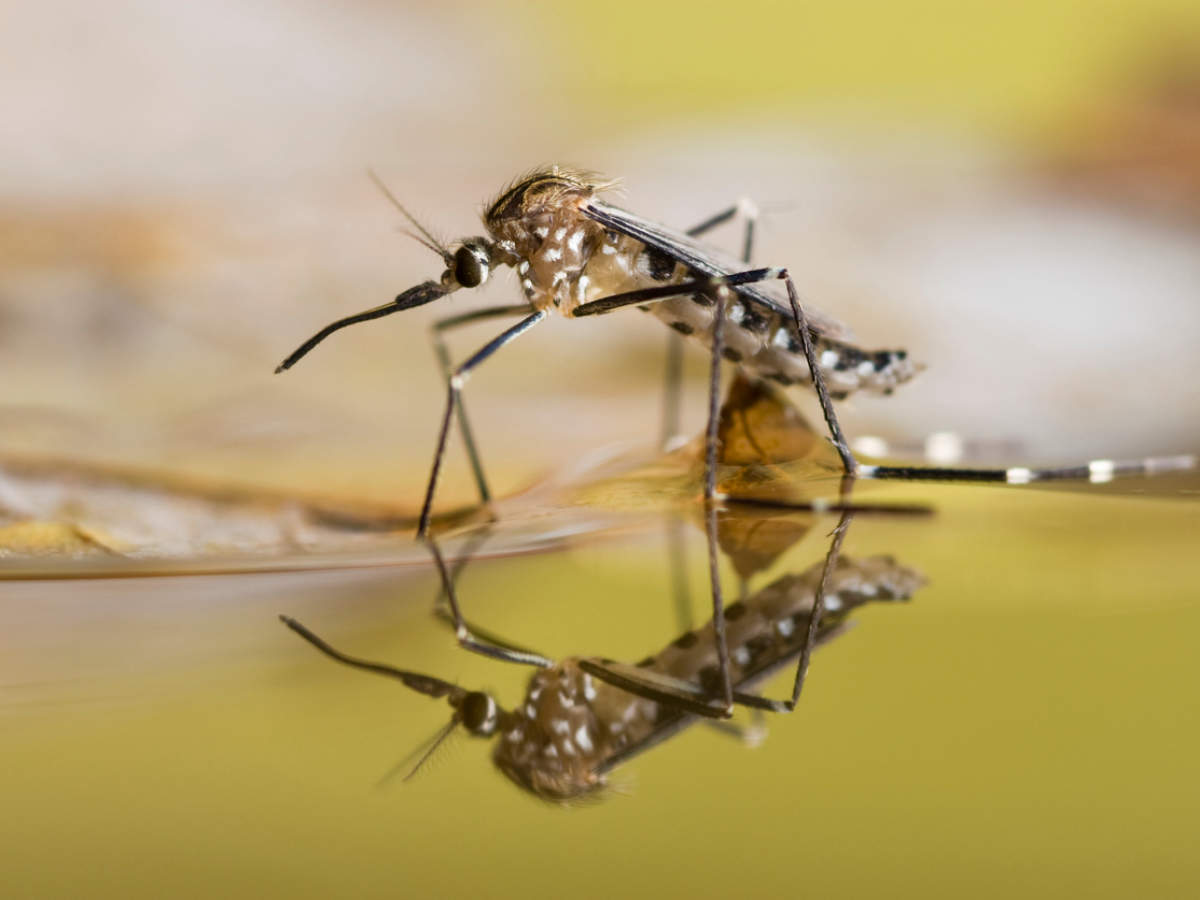The Health Benefits of Deep Breathing
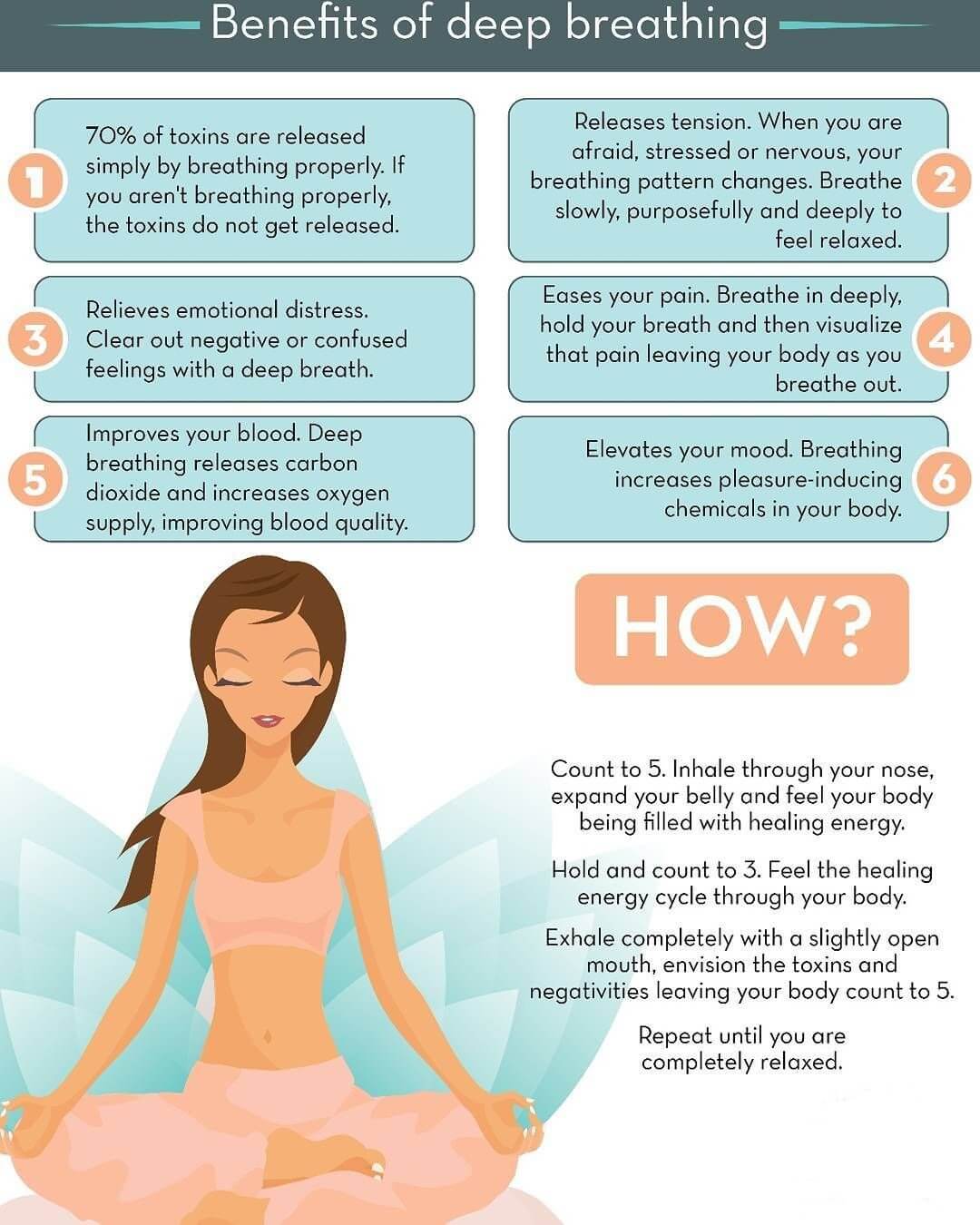 Most Americans today are unhealthy for one simple reason. They do not breathe properly. Improper breathing can bring on everything from anxiety and panic attacks to being unable to get rid of the carbon dioxide that builds up in our body. We literally starve ourselves of the oxygen we need to survive.
Most Americans today are unhealthy for one simple reason. They do not breathe properly. Improper breathing can bring on everything from anxiety and panic attacks to being unable to get rid of the carbon dioxide that builds up in our body. We literally starve ourselves of the oxygen we need to survive.
Our society has developed a very sedentary lifestyle, whether it be from working at our computers or playing video games on television. We simply do not get the exercise that we need, and as a result our bodies are not getting enough oxygen. To give you a more graphic picture, it is as if we are smothering ourselves, but instead of death coming in a short time, we are prolonging the process.
The limiting of oxygen to our bodies causes our lungs to function improperly, which can cause us to be susceptible to any number of diseases such as tuberculosis and pneumonia. It is vital to our health that we learn how to breath properly. Fortunately, there are several exercises that can be done to improve our breathing techniques.
The best advice is to start with basics. Learn the proper breathing techniques. When you are breathing correctly you will notice your stomach moving more than your chest. Also start taking in a little more oxygen each time, until you are beathing in long, slow breathes rather than short, shallow breathes. You will begin to find your mood improving and you will have more energy.
There are several websites which are dedicated to the process of healthy breathing. The most important thing is to do it. Many people have intended to start exercising, but their body breaks down before they actually get it done. If you want to save your life, start breathing.…
Velvet Disease in Fish: 5 Facts You Must Know
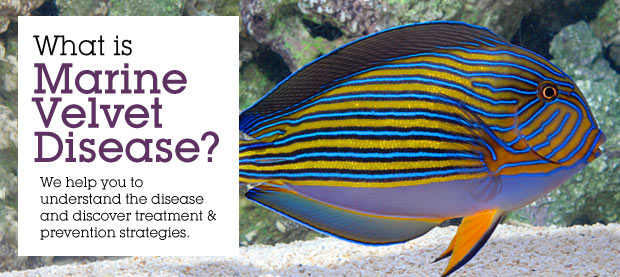 Fact 1: Velvet Disease in fish has been identified using other aliases. This disease is also called Rust, Gold Dust Disease, Oödinium. It is common in aquarium fish and some saltwater fish. Sea bass and Betta are some species known to be affected by Velvet Disease frequently. Velvet Disease appears as tiny white spots on fish. These spots are fine and give the host fish a slimy appearance.
Fact 1: Velvet Disease in fish has been identified using other aliases. This disease is also called Rust, Gold Dust Disease, Oödinium. It is common in aquarium fish and some saltwater fish. Sea bass and Betta are some species known to be affected by Velvet Disease frequently. Velvet Disease appears as tiny white spots on fish. These spots are fine and give the host fish a slimy appearance.
Fact 2: Velvet Disease in fish is highly contagious. Oödinium is a small parasite like organism that causes Velvet Disease. Classifications are mixed as it related to this parasite. Some people refer to Oödinium as protozoan while others suggest it as algae. This parasite can live in the water without feeding on a fish for up to 24 hours. After this amount of time, the Velvet finds a new host fish. Stressed fish are susceptible to Velvet disease. This disease is known to occur in crowded environments or an atmosphere where there are poor water conditions like ponds. Aquariums that do not have quality water may allow Velvet disease to flourish.
Fact 3: Velvet Disease is deadly among affected fish. The parasite attacks skin cells and gills on a fish and feeds on nutrients from them. Velvet destroys a lot of the tissue on a fish during its feeding cycle. Velvet Disease in fish may not be easy to detect until it has advanced in stages and become fatal. Fish that have severe skin infections may not respond to treatment. Putting a bright light up to the fish to examine its skin or dropping it in fresh water may help to detect Velvet. Using the fresh water method, the organisms will fall to the bottom of the water.
Fact 4: There are various symptoms of Velvet Disease in fish. One common symptom is a tired looking fish that does not have much of an appetite. The infected fish may also suffer from weight loss and have trouble breathing. Fish may also scratch itself on hard surfaces around the aquarium. Other symptoms included clamped fins and a fine yellow, dusty or gold film on the fish’s skin. Velvet Disease may also cause the skin to peel off of the infected fish.
Fact 5: A product called Acriflavine is known to treat Velvet disease in fish. Acriflavine is a dye that stains the skin. You could also treat Velvet disease with copper. Using too …
3 Strategies for the best Men’s Health and fitness

These days, increasingly more men are interested in health and fitness programs. This is not surprising since most people are concerned about obesity and health conditions today such as diabetes, heart disease, prostate cancer and more.
These are more than enough reasons to motivate anyone to get into good shape. I’m going to show you three strategies for successful men’s health and fitness.
There is no easy and quick way for you to get in good shape, so you must be prepared to put in the time and effort to achieve the desired results. A combination of a healthy diet, strength training and cardio exercises will go a long way towards your overall fitness.
Just follow these three suggestions for a healthy and strong body:
- Record Everything: You want to write down what you are doing in your exercise routine so you can see how you are progressing. First, write down your weight loss goal. Then write down each exercise for your exercise routine.
How many repetitions of each exercise did you do that day? Write it down in your log. You will then be able to see where you need to change things for the better and how well you can do. When you have achieved your weight loss goal, this is a good time to add weight in your weight lifting routine.
- Each Session: Make sure you include weight lifting three times a week in your routine. This will help you to get the best results from your training sessions.
You will now be growing your muscles. As you weight lift three, maybe four times per week, you muscles have time to increase and rebuild. If you don’t continue to push those muscles, they just go back to where they were.
- Eat Lots of Protein: When compared to women, it is much easier for men to lose weight. Men’s health and fitness programs always recommend protein to grow your muscles and to help you recover.
In general, men who are working out 4 or more times each week must eat about one gram of protein on those days for each pound of body weight. It’s also important to eat meals with 0. 25 grams of protein right after each workout.
If possible, try to eat thirty minutes after a rigorous workout because your body will need some high-quality protein to recover fully. Build your muscles by breaking down …
Parathyroid Disease
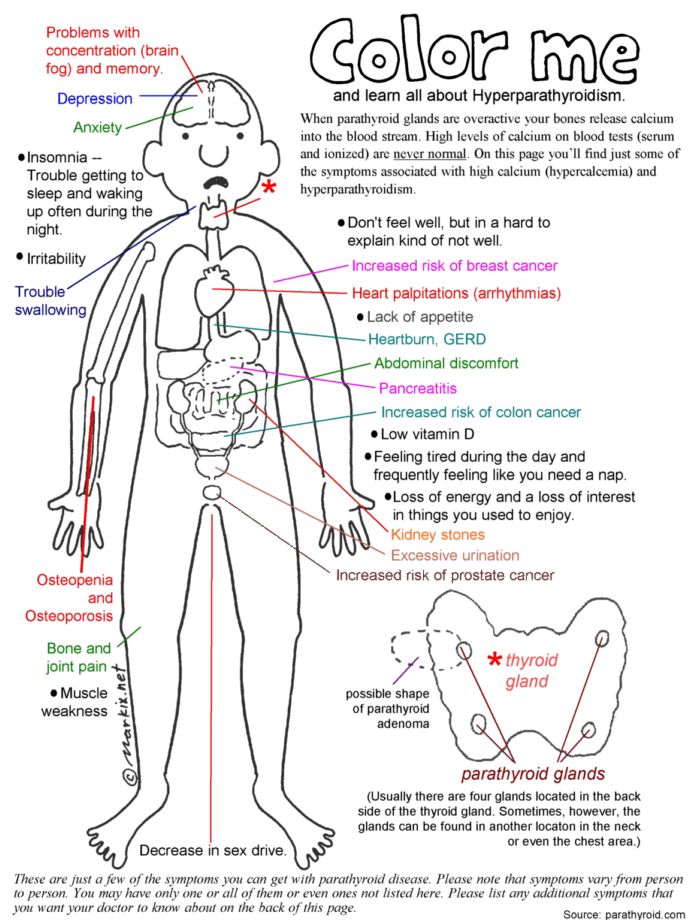 Most people do not know that they have one parathyroid, let alone four of them, but the parathyroid glands serve a very important purpose – to regulate calcium levels in the body.
Most people do not know that they have one parathyroid, let alone four of them, but the parathyroid glands serve a very important purpose – to regulate calcium levels in the body.
Calcium
It is a well known fact that calcium makes strong bones and teeth. Less well known is the fact that our muscular and nervous systems also need calcium in order to function properly. The four parathyroid glands, usually located in the neck, just behind the thyroid gland, regulate blood calcium levels to ensure proper distribution of this mineral.
When blood calcium levels fall too low the parathyroid glands produce a hormone called parathyroid hormone or PTH. PTH signals the body to release calcium from the bones and into the bloodstream where it can be carried to the organs that need it. When blood calcium levels reach certain levels the Parathyroid glands will slow or even shut down PTH production.
Primary Hyperparathyroidism
Parathyroid disease, also called primary hyperparathyroidism, results when one or more of the parathyroid glands grows abnormally and becomes a non-cancerous tumor. When this happens the over grown gland(s) produces an excess of PTH, robbing the bones of calcium and overloading other systems. Over time, high blood calcium can impact the liver, kidneys, arteries, heart, stomach, and nervous system.
Symptoms of Hyperparathyroidism
Since calcium is used by the nervous system hyperparathyroidism will usually impact the way a person feels. Many patients experience an inability to concentrate, low energy levels, depression, irritability, trouble sleeping, memory troubles, loss of interest in activities, and fatigue. Physical symptoms can include kidney stones, high blood pressure, recurrent headaches, heart palpitations, acid reflux (heartburn) and pain in the bones. All patients with primary hyperparathyroidism will eventually develop osteoporosis (thinning of the bones).
Diagnosis of Hyperparathyroidism
Simple blood tests can detect hyperparathyroidism. Your doctor will check your serum calcium levels; if the serum calcium is elevated (above 10.4) your doctor will then check your PTH levels. If PTH levels are also high then the patient is diagnosed with hyperparathyroidism. However, it is possible to have high calcium levels, but not high PTH levels. High calcium levels are always a concern and should not be ignored just because they are “slightly elevated” or do not coincide with elevated PTH levels.
Another test used to diagnose parathyroid disease is a sestamibi scan. When undergoing a sestamibi scan the patient will be injected with a mild …
Facts About RSV Disease
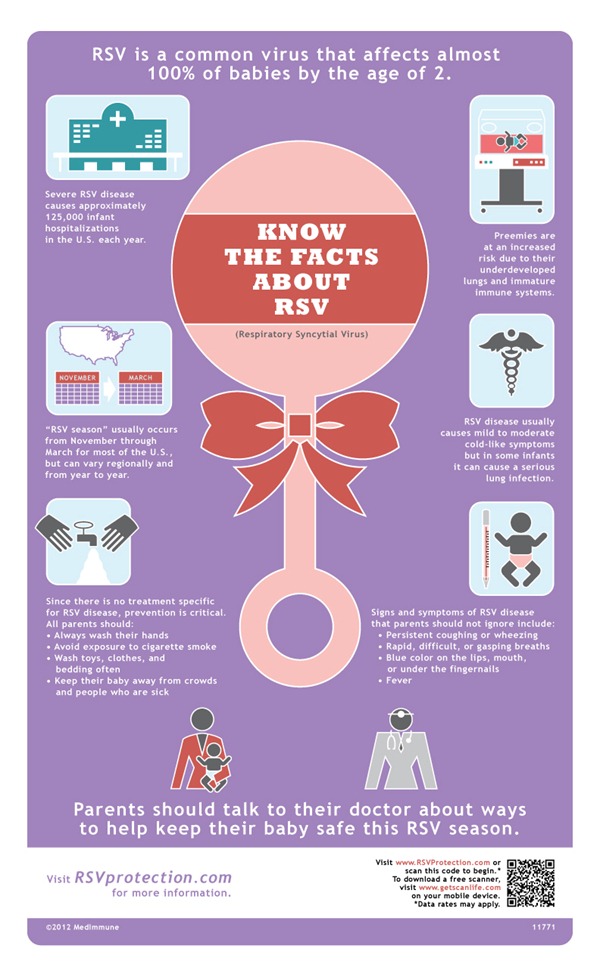 Respiratory syncytial virus, also known as RSV disease, can be a be a very serious illness and mainly affects infants and small children under the age of two. This disease is highly contagious and can be transmitted by touching someone with the disease and then rubbing the mouth, nose, or eyes. It can also be contracted by coughing or sneezing and can live for several hours on surfaces like cribs or tables. RSV disease affects around 70% of all children, some seriously, and close to 100,000 infants are hospitalized each year with RSV. Around 2% of all children have a fatal case of RSV disease.
Respiratory syncytial virus, also known as RSV disease, can be a be a very serious illness and mainly affects infants and small children under the age of two. This disease is highly contagious and can be transmitted by touching someone with the disease and then rubbing the mouth, nose, or eyes. It can also be contracted by coughing or sneezing and can live for several hours on surfaces like cribs or tables. RSV disease affects around 70% of all children, some seriously, and close to 100,000 infants are hospitalized each year with RSV. Around 2% of all children have a fatal case of RSV disease.
RSV disease can be contracted throughout the year, not necessarily in just the winter months. Though, it is most common between fall and early spring. Premature babies are highly susceptible to the disease, especially in the cold months. Early symptoms of RSV are similar to the common cold and may include a runny nose, low fever, and headache. More serious symptoms of RSV can include severe cough, wheezing, decreased or difficult breathing, rapid breathing, high fever, and the bluing of the skin due to a lack of oxygen. The disease can progress rapidly, so it is vital that you take your child to a pediatrician if you suspect RSV, or if the child has these symptoms.
There are many factors that can contribute to contracting RSV disease. Male children, premature babies, twins or multiples, babies that are younger than two months, babies with pre-existing lung or heart disorders and a poor immune system are some of the leading causes. Other environmental factors that can lead to RSV disease include babies that are in daycare, have siblings currently in school, live in a household with more than four people, bottle fed babies, and babies that are exposed to second hand smoke.
There are treatments for RSV disease, and it generally takes around two weeks for a child to get over the disease. It is wise to avoid public places or schools until this disease has been treated and passed, because it is so contagious. A treatment of antibiotics, bronchial steroids, and certain medications used to treat asthma is one of the best combinations to use when trying to get rid of RSV disease. Following the instructions of the physician and making sure your child gets their prescription medications regularly are essential in trying to treat RSV. …
Managing Cardiac Disease and Potassium Levels with Midamor
 Cardiac arrhythmia can lead to significant health complications that must be well managed to improve long term health. While there are many electrolyte complications that may arise from complications of cardiac arrhythmia, the most common is that involving abnormal potassium, sodium and magnesium levels.
Cardiac arrhythmia can lead to significant health complications that must be well managed to improve long term health. While there are many electrolyte complications that may arise from complications of cardiac arrhythmia, the most common is that involving abnormal potassium, sodium and magnesium levels.
If you live with a cardiovascular complication that has resulted in the development of cardiac arrhythmia, it is important to ask your physician about the use of medications as a way to promote electrolyte balance. When not effectively managed, electrolyte imbalance can lead to life threatening health complications.
For many patients with an electrolyte imbalance in connection with the cardiac arrhythmia, the use of prescription Midamor is quite common. Specifically, when your potassium levels are low, your physician may want to prescribe Midamor as part of your total cardiac treatment plan.
As a once-per-day dosing formula, in five milligram tablets, is generally all that is needed to assist in capturing control over your potassium levels and restore electrolyte balance. However, if your complications with cardiac arrhythmia are not sufficiently managed, your physician can increase your dosing to twice-per-day with as much as 10 milligrams per day in that same dosing.
As with any FDA approved drug, if you suffer from cardiac arrhythmia and utilize Midamor, you can expect there will be some side effects with use. Most common side effects experienced with Midamor include nausea, abdominal pain, gas and even the development of a rash. If you notice any of these symptoms or side effects are quite complex, be certain you consult your cardiologist before ceasing use.
For cardiac patients with a pre-existing history of liver disorder or complications of anemia, there may be some health risks associated with using Midamor in managing your cardiac arrhythmia. For this reason, be certain your physician completes a full physician to ascertain your liver panel results and blood levels before beginning treatment. For women who are pregnant, or may become pregnant, the use of Midamor is considered safe and classified as a Category B drug.
Cardiovascular complications can lead to adverse health risks. For many adults, the complications of the cardiac system involve the development of cardiac arrhythmia. To effectively manage your potassium levels, and balance electrolytes, consider using Midamor as an effective treatment option in a once-per-day dosing formula. Without proper management of potassium levels, your health risks can lead to electrolyte imbalance, edema, and ultimately increase the …
Treatments for Canine Kidney Disease
 According to Only Natural Pet, kidney disease is a common ailment for dogs over the age of 10. As your dog's body suffers from the normal wear and tear as the years go on, her kidneys can fail. When this occurs, knowing the different remedies available to you can help you and your dog's veterinarian decide on the best course of action for your dog's situation.
According to Only Natural Pet, kidney disease is a common ailment for dogs over the age of 10. As your dog's body suffers from the normal wear and tear as the years go on, her kidneys can fail. When this occurs, knowing the different remedies available to you can help you and your dog's veterinarian decide on the best course of action for your dog's situation.
Diet
Your dog's veterinarian may recommend a special diet to help combat the effects of kidney disease. Usually, the diet includes low protein, low phosphorus and low sodium foods. According to Healthy Happy Dogs, low protein diets are controversial amongst some vets since if they are not monitored they can cause your dog to be malnourished. However, a low protein diet produces less nitrogenous waste which means less nausea and vomiting for your dog. Reversely, some vets will recommend a diet that is higher in good quality proteins. These diets are often made from homemade foods using good quality meat. Low phosphorus diets help limit the amount of minerals that build up in the kidneys which can help slow down the development of the disease. Low sodium diets also put less strain on the kidneys.
ACE Inhibitors
Depending on your dog's specific situation, your vet may recommend a medication, such as an ACE inhibitor. These drugs, which are usually used to help humans with high blood pressure and heart disease, can help slow down the development of the disease. They are also beneficial since there are little known side effects when administrated appropriately.
Supplements
Nutritional supplements can help the development of the disease in different ways. It's common for dogs with kidney disease to have problems eating which can lead to weight loss or anemia. Some vets will recommend giving your dog B-vitamins to help encourage your dog to eat. Another common supplement is Omega-3 fatty acids, usually in the form of fish oils. In conjunction with vitamin E, they can help decrease kidney swelling.
Other Methods
If you are looking for a more holistic approach, there are steps you can take. Lowering the stress in your dog's life can help his quality of life. One way to accomplish this is to give your dog flower essences which can improve the mood on your dog. Acupuncture is another option. Acupuncture is known to slow the development of the disease and help prolong your dog's …
Depression and the Disease Process
 It may be natural for a person to experience periods of depression when they are diagnosed with a serious illness or disease, but clinical depression can also affect the progression and outcome of the disease.
It may be natural for a person to experience periods of depression when they are diagnosed with a serious illness or disease, but clinical depression can also affect the progression and outcome of the disease.
It has been known for some time that depression can have a negative affect on eating and sleep patterns, cause chronic fatigue, cause aches and pains with no known cause, as well as make a person more prone to illness and disease. For a person that has been diagnosed with a disease, depression can seriously affect their natural ability to combat the disease as well as their willpower to overcome it.
Serotonin is the neurochemical whose levels are greatly affected by depression. This neurochemical that is naturally occurring in humans not only regulates sleep, but also controls our pain threshold. When the serotonin level in the body is reduced, a person will feel more pain than someone who is not affected by clinical depression. This means that a person with both clinical depression and a serious illness may not be able to tolerate pain associated with treatments and procedures, and this may seriously jeopardize their chances of recovery.
Our bodies heal and repair themselves while we sleep. Depression wreaks havoc on our sleep patterns as well as the quality of that sleep. To a person that has been diagnosed with a serious illness, this lack of adequate or restful sleep can impede their body's healing process.
The appearance of psychosomatic symptoms that is often caused by depression can interfere with both the diagnosis and treatment of a serious illness. It is very important that a treatment team be aware of actual symptoms, and not be confused by those that don't exist. Medications and treatments are tailored to particular illnesses, and the inclusion of these psychosomatic symptoms may result in a faulty diagnosis or unnecessary treatments.
If someone that you know has been diagnosed with a serious illness or disease, it is important to monitor them for the signs associated with depression. These symptoms can include trouble concentrating, changes in eating or sleeping habits, lack of interest or participation in daily activities, changes in grooming habits, or preoccupation with death. It is vital to advise the person that has been diagnosed with a serious illness to seek the advice of their physician when they exhibit the symptoms of depression so that they will be able to …
Protecting Our Eyes

We are only given one set of eyes and they must last us our entire lives. This is why it behooves us to take care of them. Believe it or not, there are many things that we can do, on our own, to take care of our eyes. What we eat, the amount of sleep that we get, and even protecting them from the harmful rays of the sun can do a lot to keep our eyes healthy.
Sun Glorious Sun
The sun is wonderful. It provides us with vitamin D that keeps us healthy and it feels good on our skin: but too much sun can be harmful, not only to our skin but our eyes as well. Wearing sun shades protect our eyes from the harmful UV rays that could lead to cataracts. This is why you should wear sun shades if you plan on being in direct sunlight for an extended period of time.
Sleep
Getting sleep is another health boosting benefit for your eyes. Adequate sleep helps with everything from tear production to moisture. When you don’t get enough sleep there are a whole host of problems that you can develop as a result. There are even diseases that you can become more susceptible to contracting as a result of not getting enough sleep. Lack of sleep increases the amount of blood and fluid around the eyes resulting in dark circles and bags: not only does lack of sleep rob your eyes of health, it diminishes their beauty as well. When a person has sleep apnea and goes prolonged periods of time without sleep, vision loss can occur in severe cases.
Nutrition
Your eyes benefit greatly from a nutrient called lutein. It is found in green leafy vegetables. If you are not eating a balanced diet inclusive of vegetables, you may not be getting enousun to this precious nutrient. A nutrient-poor diet means that your bodies organs don’t get everything that they need: and over time, they may begin to function at a less than optimal level. This is why eating well means eating a balanced nutrient rich diet. It may not seem that your eyes dep[end on what you put in your stomach, but they do. Your eyes count on you to make good decisions about the food you consume and the nutrients that you get via the food. Eyes that go without what they …
Mosquitoes Transmit Dangerous Diseases
If you want to avoid contracting an illness from ticks or mosquitoes, then you need to contact Mosquito Squad of Dallas to talk to qualified exterminators. Mosquitoes transmit serious illnesses that include:
- Zika virus – conjunctivitis, skin rash and fever
• West Nile virus – fever and nausea
• Malaria – fatigue and fever
How to Kill and Control Mosquitoes
There are several ways to kill or control mosquitoes such as:
- Insecticides – kills adults and larvae
• Traps – captures adult mosquitoes
• Repellents – keeps mosquitoes away from your skin
• Natural predators – birds, bats and reptiles
• Nets – prevents mosquito bites at night
• Window screens – keeps insects out of buildings
• Introduction of sterile males – prevents new generations
• Eradication of breeding locations – removal of stagnant water
Avoid a Bite From a Tick
Ticks also transmit dangerous health conditions, and you will want to avoid a bite from one of these arachnids. One tick can carry several diseases, including:
- Heartland virus
• Rocky Mountain spotted fever
• Colorado tick fever
• Lyme disease
Ticks are difficult to control, but you can contact Mosquito Squad of Dallas to learn more about applications of pesticides, barrier systems or natural predators. The introduction of guinea fowl to a property is an important way to kill ticks without exposure to chemicals, but in many cases, it isn’t practical for a homeowner to own these birds.
Removing a Tick From Your Skin
While you can slap a mosquito to kill it, when a tick bites you, it latches firmly onto your skin. Removing a tick incorrectly is likely to transmit pathogens into your body, so you need to follow the recommended removal protocols. If a tick is unable to breathe, then it may detach from your skin. Use several layers of transparent tape around the arachnid to suffocate it before lifting the tape and pulling up on the tick with tweezers. Always wash your hands after removing the tick before sanitizing the area of skin where the tick was biting. Keep the tick to take it to a physician or medical facility to determine if it was carrying an infection.
Misting Systems and Barrier Control to Prevent Tick or Mosquito Bites
Barrier control and misting systems are especially important when you are having a special outdoor event such as a family reunion, wedding or birthday celebration. …

